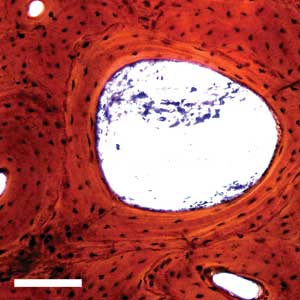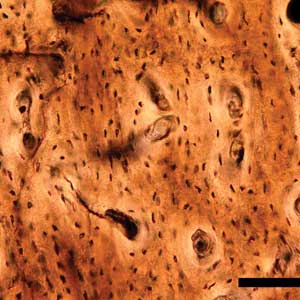|
NEWS NOTES — NEWS
Evolution
Birds evolve small genomes pre-flight
 |
| Above: A photomicrograph of a thin section of fossil bone from Deinonychus, a close relative of birds, has small dark spots that show cavities where cells once existed. The small cavity size implies that birds already had small genomes before they took to the air. |
| Below: A similarly scaled image of bone from Protoceratops, not related to birds, shows large cell cavities. Researchers used such samples to correlate cavity size with genome size. Photographs are from The Gabriel Laboratory for Cellular and Molecular Paleontology at the Museum of the Rockies, Montana. |
 |
The holes in fossil dinosaur bones are pointing out the holes in the theories of bird evolution. Researchers say that cavities in fossilized bones, used as a proxy to determine the total amount of DNA that describes a dinosaur, or its “genome size,” suggest that no direct link exists between birds’ small genomes and flight, as previous research had suggested.
The size of an organism’s genome has no relationship to the number of genes that organism has, and therefore has no relationship to complexity. Instead, genome size refers to the total amount of DNA that makes up one copy of a DNA sequence. Some of this sequence makes up genes, but much of the sequence is non-coding, or “junk DNA,” the purpose of which remains unknown to researchers. Some plants, for example, have a larger genome than humans, but are not as complex.
Birds today are known to have small genomes compared to other living vertebrates, and two trains of thought have existed to explain why this is the case. Birds could have evolved small genomes after they took to the air in order to better deal with the metabolic stresses of flight. Or, birds’ small genomes evolved pre-flight, as the result of DNA mutations within their flightless ancestors, which then allowed flight to develop. Chris Organ, an evolutionary biologist at Harvard University and colleagues say that a new statistical analysis that accounts for ancestral relationships places the small genome as existing early, among the flightless dinosaurs.
Most dinosaurs fit into either the ornithischian lineage or the saurischian lineage, the latter of which eventually gave rise to avian dinosaurs. To better define the genome size of dinosaurs of each lineage, and thus when small genomes arose, Organ and colleagues looked for biological evidence left behind in fossils. “By including fossils, we were able to get a much more articulate picture of a macroevolution or a long-term evolutionary trend in genome architecture,” Organ says.
First, however, the team studied bones of living animals to determine a relationship between bone characteristics and genome size. They found that the sizes of the pockets in the bone where cells exist are a good proxy for actual bone cell size. The team next modeled how bone cell size relates to the size of that animal’s genome. Finally, Organ and colleagues applied the model to the fossil bones of 31 dinosaur species to infer the sizes of each species’ genome.
Organ and colleagues found that cell size, and thus genome size, had already decreased in saurischian dinosaur fossils dated to between 250 million and 230 million years ago, they reported March 8 in Nature. That’s long before that lineage gave rise of the first avian dinosaurs, they say, supporting the idea that birds already had small genomes in place long before they took to the air.
Austin Hughes, an evolutionary biologist at the University of South Carolina, says that the study is “interesting,” in that small genome size developed earlier than previously thought. That earlier timing, however, does not say anything about why that change occurred, and the adaptive explanation is not ruled out, he says. It might be that the dinosaurs in question were actually birds, or at least “scurrying around,” he says. “A lot of it is an issue of semantics.”
Still, Organ says that the research lends credibility to using fossils as a means to get a better idea of the comparative biology of all animals, living or extinct. “The fact that most of the species of animals that have ever lived are extinct means that we’re really limited in the kind of comparisons we can make if we don’t include fossils,” Organ says.

 Subscribe
Subscribe


